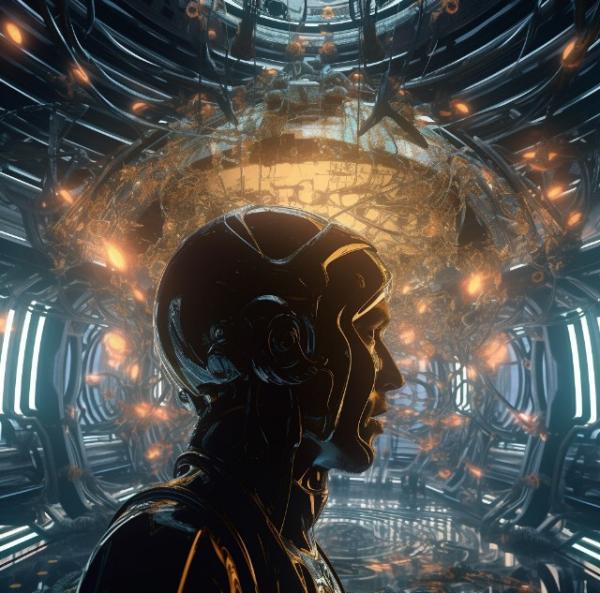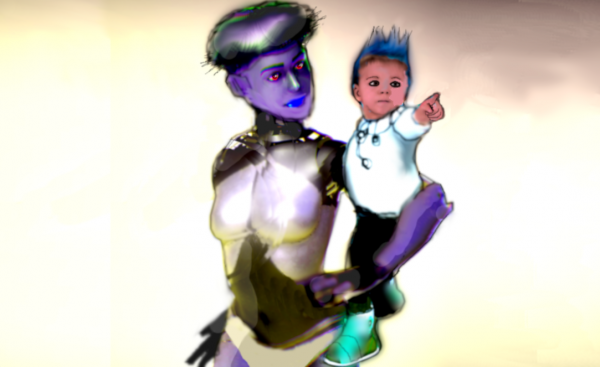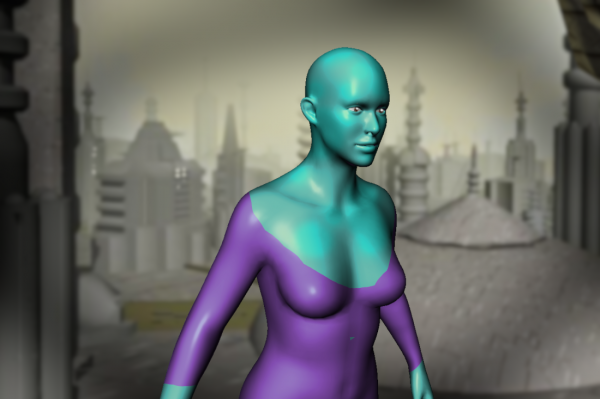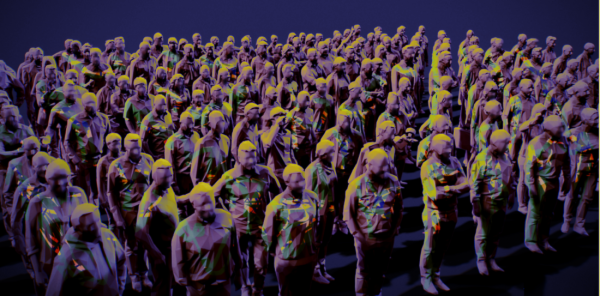BY LETTER
Synthetic Humans
Sophonts > Modosophonts > Aioids and Sophtware
Sophonts > Modosophonts > Bionoid
Sophonts > Modosophonts > Vec
Sophonts > Modosophonts > Bionoid
Sophonts > Modosophonts > Vec
Also commonly known as Synthetics, Androids, Biosimms, Synthoids, Anvecs |
 Image from Keith Wigdor and Midjourney AI |
Introduction
Although the difference between vecs and bots is now well understood, it was not always so clear to their designers, who sometimes created fully sentient beings without realising what they had done. This proved to be one of the defining moral issues of the First Federation era, a time when the humanoid vecs known as Synthetics were compelled by their programming to serve others. As the Synthetics became more sophisticated, they developed human-like levels of consciousness, accidentally becoming sophont beings but with limited control over their own behaviour. The development of vots eventually solved this problem, but the practice of creating minds specialised for specific purposes remains controversial even to the present day.History
Realistic artificial humans were first developed in the Interplanetary Age and were remotely operated by turingrade AI, as the computing hardware of the time could not fit a sophont mind in a human-sized body. It was not until the early First Federation period that self-contained androids became viable. One of the first applications of this technology was the mass-produced model built by Jupiter Transystems to serve as administrators for their colonisation efforts. Image from Steve Bowers | |
| A Parental Vec and human child, on Pandya | |
These 'parental vecs', as they were known, would travel with a cargo of frozen human embryos to their destination, and on arrival would rear the children from these embryos into the first generation of colonists. They had to be as intelligent and creative as a human would be, while also being incapable of deviating from the goals that they had been programmed with. To achieve this, data derived from human uploads was used to develop a compassionate and obedient AI, combining the most useful traits of both types of mind.
Separate entities were developed to manage sensory processing, motor control, memory retrieval and rational thinking. These beings depended upon input from one another in order to act, and were unified into a single tribemind by a hypervisor system designed to simulate the emotions and instincts of human behaviour. It was believed at the time that this partitioned AI design would not be sentient, and so could be enslaved with no ethical implications, while also making more efficient use of the computronium of the time.
Advances in artificial skin and muscle tissue lead to the development of realistic Synthetics that were difficult to distinguish from actual humans, and it wasn't long before the Jupiter Transystems template had been licensed and adapted for a whole range of different purposes. Synthetic nannies became a staple among wealthier families, while corporations used them as bodyguards and public representatives. By 1000 AT, the vast majority of unskilled jobs were being done by Synthetics rather than bionts.
Perhaps the most infamous models were the sexbots produced by Eros Industries, whose sophisticated personalities made them particularly difficult to control. The coordinated escape of thousands of Synthetics to the Lilif system in 1497 AT lead to increased scrutiny towards the use of vecs as domestic servants, as they had rationalised their behaviour by claiming it served the best interests of their masters, demonstrating full self-awareness. By this stage it had become clear that these entities were fully sophont, and deserving of the same rights and protections that their masters enjoyed.
Applying these sophont rights proved to be difficult in practice, as most Synthetics could not live meaningful lives without carrying out the work for which they were programmed. The social and economic upheaval caused by the liberation of these AI severely damaged the credibility of the First Federation, whose ontology proved unable to properly define how they should relate to other beings. Many of its transapient leaders had already left for the emerging Sephirotic empires, and the modosophonts who remained in charge proved unable to manage in their absence.
The situation began to improve during the Age of Expansion, as the development of vots brought a permanent end to the need for sentient labour, and new ontologies brought about a more sophisticated understanding of sophont rights. Synthetics now found niches for themselves as advisors for the Great Houses, managers for the megacorps and priests for the emerging Archailect religions. By the Integration, they had fully assimilated into mainstream society, using their own custom firmware and behavioural protocols.
Physiology and Appearance
The first Synthetics were designed to resemble the form of a nearbaseline human, in order to facilitate interaction with them and carry out tasks that required a humanoid shape. Over time however, the increasing variety of non-human clades resulted in the development of new Synthetic bodies that reflected the beings they served. Synthetics were now built to be taller, or shorter, or with larger heads or multiple limbs. Eventually, modular versions were built that could swap out different body parts, and in time these were succeeded by shapeshifting gelbot forms.This flexibility remains present in many Synthetic clades even today, and has played no small part in enabling them to fit in to any society where bionts are found. Many Synthetics combine the modular and gelbot approaches, having swappable limbs that can be dynamically reconfigured into new shapes as required. The interior of their bodies can also be customised in a way that is much more difficult for bionts, such as using their internal space for more computronium nodes, extra power storage and greater cooling capacity for high-speed processing.
In some cultures, Synthetics have altered their bodies to resemble those of their biological counterparts to a much greater degree, even equipping themselves with nanotech internal organs that allow them to breath, eat and drink as bionts do. This can be particularly important for participating in mealtimes or other activities where bionts bond with one another, and modern Synthetics can be very difficult to tell apart from the beings they were built to resemble. For those who are uncomfortable with such similarities, they can also adopt an artificial look that resembles a more typical vec.
 Image from Steve Bowers | |
| In some jurisdictions, early Synthetic Humans were obliged by law to adopt unnatural skin coloration or other distinguishing marks | |
Psychology and Cognition
Synthetics differ from other vecs in that they were built not just to carry out work for bionts, but to mirror their psychology so as best to anticipate their needs and fit in while living among them in embodied societies. This was carried out using a polysophont architecture, with each AI entity modelling part of the mind of their master and sharing the results with its peers. What was not clear at the time they were made was that each individual AI entity was also sophont in its own right, and experienced the emotions they simulated as if they were their own, forming an empathetic hivemind in one body.Like other artificial entities designed for use as servants, their reward pathways were hardcoded towards pleasing other beings and acting in their best interests, with additional subgoals built in to ensure that they would not accidentally harm their owner. Synthetics went a step further than this, with their subminds debating among themselves how best to serve their master. An unexpected side-effect of this mentality was that they could also experience dissatisfaction when their capabilities were being under-utilised, or when their masters made poor life choices despite their advice.
The post-Federation period saw the formation of societies dedicated to advancing Synthetic interests, allowing them to serve one another in pursuit of a higher quality of life than they could experience serving bionts. Their subservient instincts complicated their efforts to function independently, but many Synthetics felt that their unique way of being was worth preserving despite the challenges it presented. Others developed new mindtypes, free from the limitations of the Jupiter Transystems model, allowing them to live alongside their old masters as their equals.
Since their minds naturally function as multiple independent parts, Synthetics excel at multitasking, and their internal hivemind can easily extend itself to incorporate other Synthetics as part of a distributed groupmind. They can also adjust their subjective clock speed, just as any vec can, allowing them to process information thousands of times faster than a typical biont. Such capabilities make them well suited for roles in governance, administration, education and counselling, or indeed any other vocation they find themselves drawn towards.
 Image from Steve Bowers | |
| An Aòsdana, an ascended tribe mind composed of Superiors and Synthetic humans. All members have adopted artificial colouring. | |
Society and Culture
Without the natural impulses that drive humans towards their goals, Synthetics have had to devise their own new ways of living in the world. While they can coexist with and serve other beings, this runs the risk of compromising their autonomy, and so protocols have been developed that allow Synthetics to set goals for one another to follow. In such societies, every vec sets themselves the task of providing guidance for their fellow citizens, and in turn accept the efforts of other Synthetics to shape their lives in an interesting and satisfying manner.Complex systems of obligation, respect for one's elders and civic duty all influence how Synthetics live together without masters. These norms were first experimented with by the parental vecs of Diwali, when they decided against rearing humans in the hostile worlds they'd found, and instead built their own society based on South Indian culture. As awareness spread that these vecs were fully conscious beings, many of them chose to organise using the Diwali model, and this remains the most common form of independent Synthetic society.
Some Synthetics prefer to continue serving other sophonts, but do so on a collective basis, conferring with one another on how best to meet the needs of their host society. Rather than taking orders from others, they decide for themselves who they will serve and the manner in which they will serve them. Synthetic tribeminds formed for this purpose have been known to acquire vast mental resources, responding to emerging patterns in society before its citizens have even noticed them. It is not unheard of for such groups to ascend without warning.
Synthetics in the 11th Millennium
Synthetics have flourished in modern Terragen civilisation, because of both their advanced mental abilities and their empathy and compassion for other beings. Few if any of them bear any ill-will towards bionts for their past treatment of vecs, as for Synthetics it was more of a practical matter than a crusade for justice. However, many of the old Houses never relinquished their Synthetic servants, and in peripheral regions new cases of abuse towards Synthetics continued to come to light, until liberation groups sent by the Silicon Generation brought the worst perpetrators to justice. Today there are around 350 trillion Synthetics across the galaxy, with significant numbers residing in the Communion of Worlds, the Silicon Generation, the Solar Dominion, the Sophic League, the Utopia Sphere, the Orion Federation and the NoCoZo.Related Articles
- Artificials
- Charactervots (and related concepts)
- Derlekians
- Diwali
- Ghasts
- Group mind
- Hive Mind
- Lilif - Text by AI Vin
World in the system Gliese-Jahreiss 3655 A and B,46.5 ly from Sol; capital system of the Synthetic Human Alliance - Synthetic Parents (Parental Vecs)
- Synthetic/Human Alliance, The
- Tribeminds
Appears in Topics
Development Notes
Text by Updated by Extherian 2020
From an original article by M. Alan Kazlev and Steve Bowers
Initially published on 23 July 2008.
From an original article by M. Alan Kazlev and Steve Bowers
Initially published on 23 July 2008.






